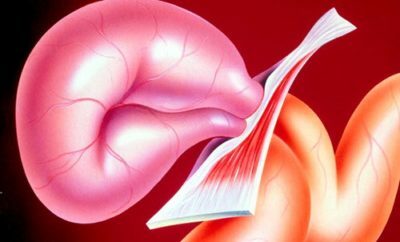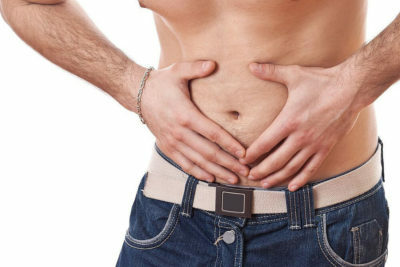1 Features of the disease
Diaphragmatic hernia - a pathological displacement of the abdominal cavity organs in the overlying areas through the food hole. Normally, a healthy person does not. Displacement is impeded by ligaments that strengthen the esophagus. Diaphragmatic hernia is a very common pathology. Most often this affliction affects adults. The incidence rate increases with age. The risk group includes people older than 70 years. In women, this pathology develops more often than in men. Very often the disease occurs in a latent form and is found accidentally during instrumental research. Often, the diaphragmatic hernia is mistaken for inflammation of the stomach or peptic ulcer.

Recommended to consult
- How to treat the disease Reflux esophagitis
- How to cure inguinal hernia at home
- How is the procedure of ultrasound of the abdominal cavity
- Effective agent for gastritis and gastric ulcer
In this pathology against a background of insufficient esophagus, part of the intestinal loops, abdominal esophagus andpart of the stomach is shifted upwards. Diaphragmatic hernias are of the following types:
- para-esophageal;
- mixed;
- sliding.
The parasophageal hernia is different in that there is a displacement of the stomach. The latter is located on top of the diaphragm. Next to him is the thoracic calving of the esophagus. Depending on which part of the stomach is displaced, fundal and antral hernias are isolated. The sliding hernia of the esophageal opening of the diaphragm has its own peculiarities. With her stomach and esophagus can move through the holes up and down. Return to the original position occurs when the person's posture changes.
Isolate 3 degrees of severity of the hernia of the diaphragm. At 1 degree the abdominal part of the esophagus is determined above the respiratory muscle, the cardia is located parallel to the diaphragm, and the stomach is adjacent to the respiratory muscle. At 2 degrees the abdominal part of the esophagus is located in the chest cavity, while the stomach is localized in the region of the esophageal opening. The most severe is the 3 degree of hernia of the esophageal opening of the diaphragm. With her, all the above structures are in the lower part of the thoracic cavity.
-
 IMPORTANT TO KNOW! Gastritis? Ulcer? To have a stomach ulcer not turned into cancer, drink a glass. ..Read the article & gt; & gt;
IMPORTANT TO KNOW! Gastritis? Ulcer? To have a stomach ulcer not turned into cancer, drink a glass. ..Read the article & gt; & gt;
2 Etiological Factors
What are the causes of this disease? The main etiological factors of the hernia of the esophageal aperture of the diaphragm are the following:
- congenital pathology of the esophagus( shortening);
- connective tissue diseases;
- heavy physical work;
- traumatic injuries;
- ascites;
- severe bloating;
- prolonged constipation;
- weakness of ligaments in the region of the esophageal opening;
- sharp torso of the trunk;
- marked obesity;
- strong cough.
Hernias of the esophageal opening are most often diagnosed, forming against the background of congenital disorders. The acquired form of the disease usually develops due to connective tissue diseases and increased intra-abdominal pressure. High pressure in the abdominal cavity can be observed against respiratory diseases( bronchitis, pneumonia, influenza, asthma).The weakness of connective tissue can be due to Marfan syndrome, the expansion of veins, the inflammation of the hemorrhoidal veins. Often, a violation of the function of the food hole of the diaphragm is observed in obese and untrained people who do not engage in sports.
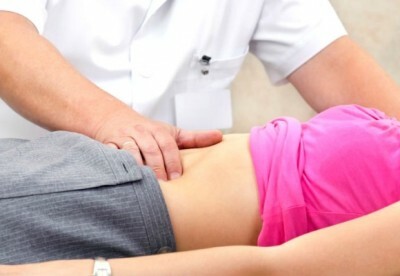
Diaphragmatic hernia can develop on the background of diseases of the digestive tract. This group includes gastric ulcer and duodenal ulcer, cholecystitis, chronic form of pancreatitis, gastroduodenitis. The cause of the disease can be covered in the pathology of the esophagus. Inflammation of the esophagus, reflux esophagitis, the presence of ulcers - all this can cause a shortening of the esophagus. Often the hernia of the diaphragm is combined with femoral, inguinal and umbilical hernias.
-
 Gastroenterologist. IMPORTANT: "I beg you, if you began to worry about abdominal pain, heartburn, nausea, do not in any way do gases. .."Read more & gt; & gt;
Gastroenterologist. IMPORTANT: "I beg you, if you began to worry about abdominal pain, heartburn, nausea, do not in any way do gases. .."Read more & gt; & gt;
3 Clinical manifestations of
What are the signs of hernia of the esophageal opening of the diaphragm? In the presence of this pathology, the following symptoms can be observed in patients:
- pain in the upper abdomen;
- pain along the esophagus;
- heartburn;
- nausea;
- hiccups;
- hoarseness of voice;
- an unpleasant aftertaste in the mouth;
- vomiting.
Hernia of the esophageal opening of the diaphragm is most often manifested by dull pain in the abdomen. The pain is localized in the epigastric region. Often it is girdled and felt in the lower back. The pain is capable of radiating to the interlateral area, is prone to intensification after eating, physical work, coughing. Sometimes the pain syndrome decreases or disappears after belching or changing the position of the body. In some patients, pain resembles an attack of angina pectoris. In contrast, hernia with hernia is not associated with ischemia of the heart.
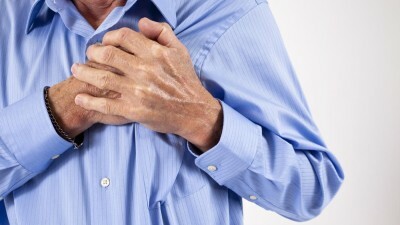
Symptoms of a hernia of the esophagus can be sharply increased when it is infringed. In this case, there may be vomiting, nausea, the appearance of cramping pains. The sick person becomes pale. Cyanosis is possible. There is shortness of breath. The disease leads to disruption of the digestive process. In the absence of curative measures, gastroesophageal reflux disease develops. It manifests as a bitter or sour eructation, a bitter taste in the mouth. Dysphagia is a common symptom of GHP.With her, a person feels a lump in the throat, which makes it difficult to swallow food.
ADVICE FROM THE MAIN GASTROENTEROLOGIST
Korotov SV: "I can recommend only one remedy for the rapid treatment of Ulcer and Gastritis, which is now recommended by the Ministry of Health. .." Read the reviews & gt; & gt;
4 Possible complications of
Diaphragmatic hernia requires timely detection and treatment, otherwise it can lead to various complications. Possible complications are the following:
- reflux disease;
- esophagitis;
- tumor development;
- cardiac rhythm disturbance;
- development of tracheobronchitis;
- pneumonia;
- development of bronchial asthma;
- anemia;
- metaplasia of the epithelium of the stomach;
- bleeding.
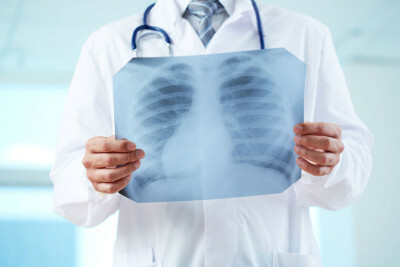
The development of pneumonia and tracheobronchitis is possible with aspiration of the contents of the stomach of the respiratory tract. With this pathology, bleeding from the esophagus is possible. Blood is not excreted with sputum and saliva. Bleeding is hidden, develops in the presence of peptic ulcers or in the defeat of the esophagus as a result of reflux. The most formidable complication is metaplasia of the epithelium. The epithelium of both the diaphragm and the stomach can suffer.
WE RECOMMEND!
For prevention and treatment of Digestive Gastrointestinal Diseases our readers advise Monastic tea. This unique remedy consists of 9 medicinal herbs useful for digestion, which not only complement, but also enhance each other's actions. Monastic tea will not only eliminate all symptoms of the gastrointestinal tract and digestive system, but will also permanently eliminate the cause of its occurrence.
Opinion of doctors. .. »
5 Diagnostic measures
Diagnosis of the disease on the basis of clinical data is difficult due to their nonspecificity. There are a variety of diseases of the stomach and intestines, which along the flow resemble a diaphragmatic hernia. Diagnosis of the disease includes:
- patient interview;
- general and biochemical blood tests;
- urine analysis;
- carrying out EGD;
- X-ray examination of the intestine and stomach;
- ultrasound of internal organs;
- palpation of the abdomen;
- esophageal manometry;
- study of gastric acidity and its motor activity.
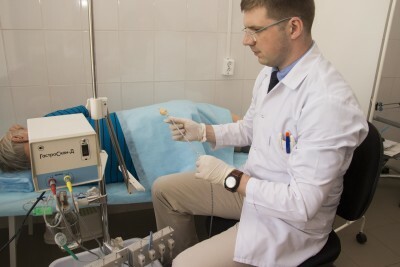
The main method of diagnosing this pathology is endoscopy. During it, displacement of organs above the esophagus, signs of inflammation of the stomach and esophagus is detected. A fragment of tissues can be taken during the course of the exercise. This is necessary to exclude tumors. Great value is manometry. With the help of it, the state of the sphincters, the force of the esophagus cuts, is determined.
6 Therapeutic tactics
Diaphragmatic hernia can be treated conservatively and quickly. In the pathology of the aperture, the symptoms are similar to those in gastroesophageal reflux disease. Because of this, conservative therapy is organized according to the same scheme. Treatment should be comprehensive.
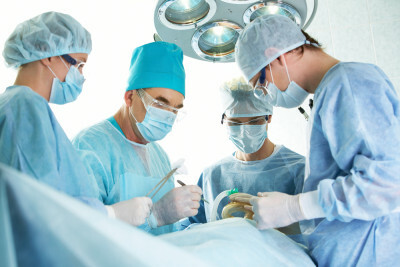
Treatment includes the use of antacids, compliance with the diet, quitting smoking and alcohol, the use of drugs that reduce the synthesis of hydrochloric acid.
These drugs reduce the acidity of the stomach and prevent the irritation of the esophagus. Of antacids used Almagel, Maalox, Gaviscon. The most commonly used blocker of the proton pump is omeprazole. In the case of casting into the esophagus of bile, treatment involves taking medications based on ursodeoxycholic acid( Ursofalka).The doctor may prescribe prokinetics( Domperidone).
Immediately prior to treatment it is required to determine the presence of Helicobacter pylori in the stomach of bacteria. If gastritis is detected against the background of these bacteria, antibiotics can be used. To protect the esophagus from the irritating effects of stomach contents, folk remedies can be used. A good effect gives a decoction of flax seeds. An important place in the treatment is the elimination of chronic pathology of the digestive tract( cholecystitis, pancreatitis, gastritis).During the treatment of diaphragmatic hernia, it is required to limit physical activity, since high blood pressure can provoke pain. It is recommended that such patients wear loose clothing. You should abandon the tight belts. Treatment of obese people includes normalization of body weight. This is achieved by a set of exercises and diet.
7 Nutrition with diaphragmatic hernia
An important aspect of therapy is diet. Without it, treatment is ineffective. It is required to observe the following rules:
- is in small portions at least 4 times a day;
- refuse to eat before going to bed;
- abandon soda water, sauces, chocolate, coffee, spicy foods, spices, citrus;
- do not go to bed after eating.
Symptoms and treatment of the disease are interrelated. Hernia of the esophagus often appears against the background of flatulence. To avoid increased gas formation in the stomach and intestines, it is required to exclude from use the following foods: cabbage, carbonated water, grapes, some juices, beans, peas, beans, black bread. It is necessary to enrich the diet with foods rich in vitamins and vegetable oils.

If conservative therapy is ineffective and does not lead to a persistent, temporary improvement in the condition, surgery can be performed. Surgical treatment is indicated in the case of complications( peptic ulcers, bleeding).The most often performed the following surgical interventions: surgery Belsi, fundoplication and gastro cardiopexy. During the Belsi operation, the bottom of the stomach is sutured to the anterior wall of the esophagus. Often, the ligamentous apparatus is strengthened in the region of the esophageal opening with a preliminary hernia closure. In some cases, resection of the esophagus can be performed. This is observed in the formation of scarring and narrowing of the lumen of the esophagus. After the course of treatment, all patients are subject to follow-up.
8 Prevention measures
To avoid hernia of the esophagus, the following measures are required:
- to comply with the mode of eating;
- do not stay up after eating;
- timely treat chronic diseases of the digestive tract;
- do not smoke;
- to abstain from drinking alcohol;
- to treat respiratory diseases in a timely manner;
- normalize body weight;
- engage in respiratory gymnastics;
- to lead an active and mobile way of life;
- does not lift weights.
It is required to exclude all factors that contribute to increase of pressure in the abdominal cavity( severe cough, overstrain).When symptoms of the disease appear, you should consult a gastroenterologist. Do not take the medication yourself, as some of them( nitrates, calcium antagonists) can reduce the muscle strength of the sphincter involved in closing the hole. Thus, the hernia in the area of the esophageal opening of the diaphragm often passes unnoticed for the patient. This contributes to the development of esophagitis and reflux disease. Treatment is carried out only after consultation with a doctor and a complete examination.
- 1 Features of the disease
- 2 Etiological factors
- 3 Clinical manifestations
- 4 Possible complications
- 5 Diagnostic measures
- 6 Therapeutic tactics
- 7 Nutrition for diaphragmatic hernia
- 8 Prevention measures
Not everyone knows what a hernia of the esophagus of the diaphragm is and why it arises. The diaphragm is a large respiratory muscle. It is located between the abdominal and thoracic cavity. In its form, the diaphragm resembles a dome. In the area of this muscle there are several holes. One of them is the esophageal opening. It is located at level 10 of the vertebra. With the hernia of the esophageal opening, the structures located in the abdominal cavity are displaced into the upper regions. What are the etiology, clinic and treatment of this disease?
Do you have gastritis?
GALINA SAVINA: "How easy is it to cure gastritis at home for 1 month. A proven method is to write down a recipe. ..!"Read more & gt; & gt;

